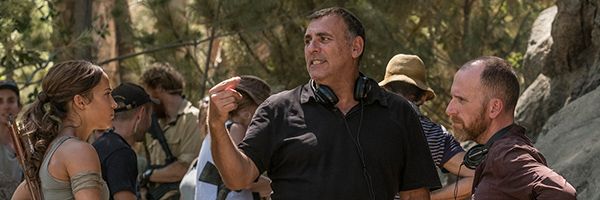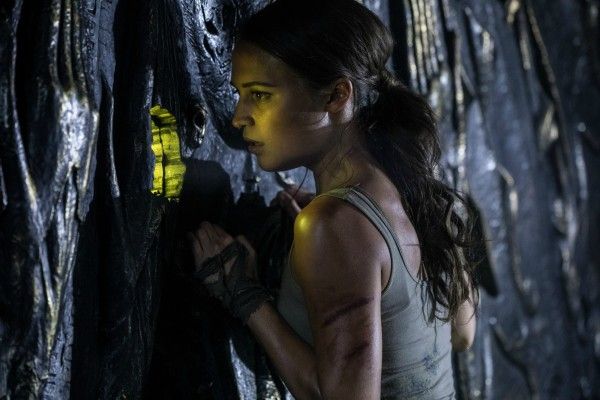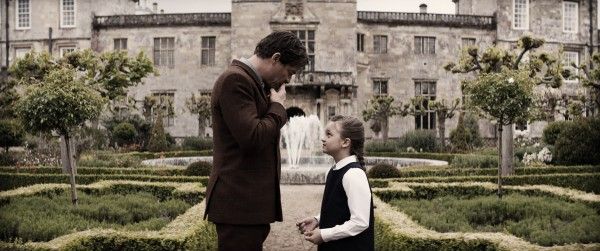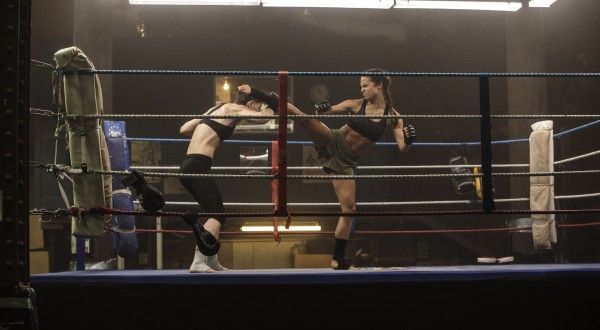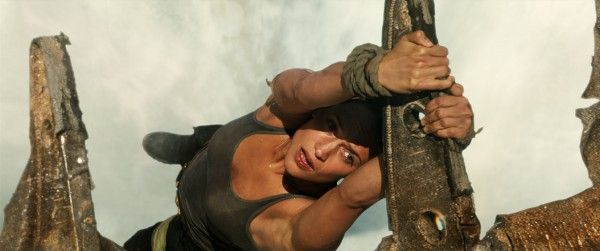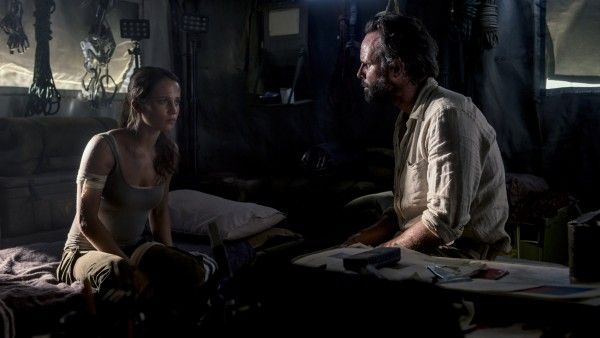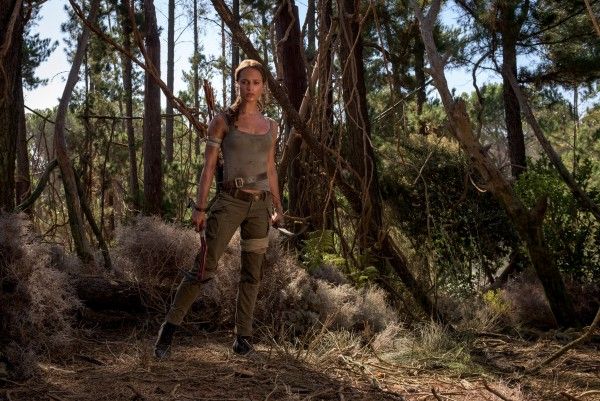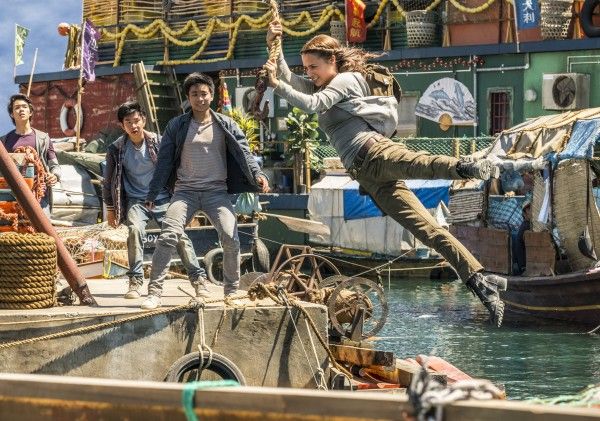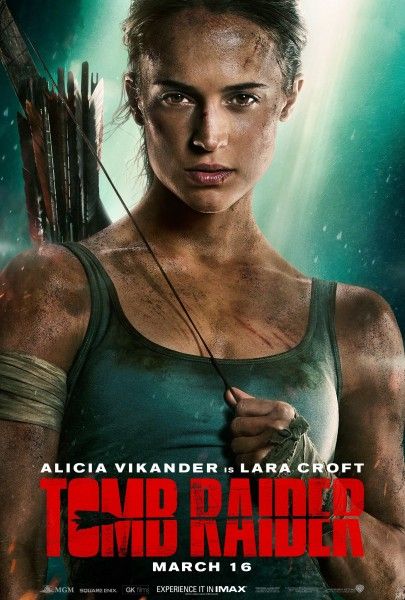With Warner Bros. and Metro-Goldwyn-Mayer Pictures' Tomb Raider opening this weekend, I recently saw down with producer Graham King for an exclusive video interview. He talked about why he acquired the rights to the Tomb Raider movies, the challenges of telling a story that primarily takes place on an island, making a movie that works for both moviegoers and gamers alike, if it’s challenging to get someone to sign on for a multi picture deal, what they learned from test screening the movie, which action sequence was the toughest to pull off, and a lot more. In addition, he shares why his deal for Rob Liefeld’s “Extreme Universe” fell apart, how excited he is for people to see Bohemian Rhapsody, how the first time he saw Gangs of New York it was a four-hour cut, and more.
As most of you know, the action/adventure remake of Tomb Raider and the original video game stars Alicia Vikander as Lara Croft. In this new version, Lara Croft is a 21-year-old bike courier in East London who refuses to follow in her father’s entrepreneurial footsteps. Once she decides to search for her father’s last-known destination though (a fabled tomb on a mythical island off the coast of Japan), she must learn to push herself beyond her limits as she journeys into the unknown. Tomb Raider also stars Dominic West, Walton Goggins, Daniel Wu, Derek Jacobi, and Kristin Scott Thomas.
Check out what Graham King had to say below.
Collider: Tomb Raider is a super popular franchise. It’s a popular video game. Talk a little bit about bringing it back to movie screens and maybe what was the big challenge that needed to be overcome to finally get it back on to screens.
GRAHAM KING: Well, I think like anything you are adapting from a book or a video game it’s framed that way to have a cinematic experience for an audience. This one was particularly tough because she goes to an island where nothing really happens. You’re kind of going, well, how do you keep an audience engaged? There are a lot of scenes where it’s just her on the island. How do we keep an audience engaged through that part of the film? How do we keep them connected to this story and not have a young audience start texting or losing focus? I think Geneva found a great way to keep tension going, to keep emotion going. Then when you have someone like Alicia playing this part, who plays it so grounded, that you really are sucked into it- to where she could literally do anything and get away with it. From the moment she jumps in that river, all the way through till she sees dad, she is basically on her own on the screen. She has that first kill with a guy in the jungle, which I think is an incredibly emotional moment- her realization that she has just killed someone for the first time. That was the biggest obstacle in developing this, how do we keep that island accessible and keep an audience engaged with that.
The other thing about this is that Tomb Raider is one of the only video games that has made a successful jump to the big screen and been a franchise. Talk a little bit about the challenge of adapting a game and putting it on the screen, where you have to engage the gamers and make them happy, but you also have to engage moviegoers.
KING: That’s why it took so long (laughs), in a way. You know, you talk to people on the street and you tell them you’re making a movie out of a video game title, or of an older franchise, and they go, “Ugh, really? How are you going to do that? Is that going to be exciting? Is that going to be fresh to an audience?” I give a lot credit to MGM and Warner for backing us for this because it’s a big movie. For me, it was the storytelling. It was all about the storytelling. I think I was working with Angie when I bought the rights to Tomb Raider and I remember telling her on set, I am going to reboot Tomb Raider. She’s so proud of that franchise; she was really happy that I bought the rights. And she asked me, “Why? What do you see in it?” And I said, I see a lot of heart in this. When I got pitched in the game in 2013, the father daughter relationship didn’t feel like a genre video game movie to me. A girl goes off in search to find dad, is he dead or alive? Finds him alive, reconnects with him, and then he sacrifices himself. That right there is a premise for a good drama, let alone Lara Croft. You build from that and from those elements.
I think what we found watching the game, building the film, watching the game, going back and forth, saying that doesn’t work cinematically, or this part of the character needs to do something different to keep a movie-going audience. In my head, it was always thinking about audiences who don’t play video games. That’s the key. If we can win on that level, we can get the gamers. So, it was always about focusing on that- sitting with writers, sitting with Geneva, saying how are going to keep them engaged in certain areas emotionally? Are they going to buy into this character that doesn’t start off a superhero- starts off as a very normal, grounded girl? London, for example- I always wanted to get away from the Buckingham Palace looking, Tower of London looking- put it in the east and make it gritty, and bring a grounded-ness to it. So, young audiences will follow her at that age. They will be engaged with her because it’s normality- she’s a food delivery girl, and then she goes off on her journey. And slowly, but surely, turns into Lara Croft. It doesn’t happen immediately, and it’s a very emotional moment, as I said. I think audiences- when I have shown this to audiences, whether it has been my kid’s friends or whatever; they have been emotionally engaged in a genre picture. If we can capture that, then we can capture an audience that are not gamers.
I’m curious as a producer- nowadays everyone is looking at universes. It’s very popular. How hard is it to cast someone knowing that they’re going to have to sign a 3 or 5 picture deal because you have to ensure that you can make multiple movies and not go back for these crazy negotiations.
KING: Yeah, I think that goes in with, “Hey, do you want to play Lara Croft?” It’s an automatic, for anyone…we’re going to reboot a franchise, and hopefully it turns into its own franchise. So, we need her to commit to more than just one film. She saw that immediately and that’s what she wanted out of this. I don't think anyone wants to reboot a franchise and just have one movie, right? So, for me the battle was: we’re going to the girl that just one the Oscar for Danish Girl and asking her to play Lara Croft. I remember saying to my team, “Let’s pitch her the story before we tell her it’s Lara Croft in Tomb Raider.” I think she’ll get in engaged in the storytelling aspect of the film. So, we went, ok let’s just get it all out there, and she immediately took to it and got engaged by that storytelling- by the emotional part, the dramatic part of the film. The set pieces are set pieces and she had a lot of fun. Boy, did she work her ass off, I mean, wow.
Every day in incredibly tough conditions- 100 degree heat in a jungle in South Africa, and this girl was showing up every day 6 AM in the gym, working out, hair and makeup, on that set shooting all day, going home, trying to get as much rest as she could, coming back the next day for 100 days. That wears on someone. For me to be there every day and see it- we’re producers, we sit there in the chair and we’re on the phone or doing our thing and she’s doing this. It was like, woah, woah woah, is there any way we can get you a rest or whatever and she never complained. She never said, “I can’t do this anymore,” or “I need a couple of weeks down.” She got a lot bruises and little injuries. It was just her passion to play this, in a way that, again, we saw very early on how grounded she was playing it, and how believable she was playing it. That’s why I think people will just go, “Woah, what a performance!” You see it; it’s all on screen.
Something that I am very excited about that you’re currently working on is the Rob Liefeld’s, “Extreme Universe.” I definitely want to know how that’s progressing because he has so many characters that are ripe for the big screen or small screen.
KING: Yeah, we didn’t actually close that deal (laughs). Yes, nothing to do with Rob, who I love. There was a lot of chain of title legal issues on the universe, and my lawyers were like, “this is going to be very tough.”
I’m so disappointed.
KING: I saw something in that as well, a ways back. We didn’t continue re-engaging. There are a lot of films in the past I wanted to make where there’s all these legal and chain of title problems, where you just can’t really take it on and you’re opening yourself up to legal issues.
I’ve heard this from other people. I didn’t realize that that had happened. Super disappointing, let’s switch to something else. I talked to you about this years ago- I am a huge Queen fan.
KING: I can see the nails, they’re like Freddie.
I couldn’t be more excited to see the movie. What can you tease people about how the film came together and about getting Freddie on screen?
KING: As most people know, this has been my passion project for a lot of years. I don’t want to talk too much about Bohemian Rhapsody because I am here for Tomb Raider, but I am really excited about this film and the way it turned out. I just cannot wait to get it out there and show everyone and I think people will just fall in love with this film. I just think we’ve got a really major film on our hands.
What did you learn from the Tomb Raider test screening process and friends and family screenings that impacted the finished film?
KING: Mainly, did we keep an audience engaged? Were they emotionally engaged? Were they enjoying the film, enjoying the ride, enjoying each character? You know what focus groups are, and you know how that process works. You take the majority and say well, “This was a bit confusing,” or “That was a bit confusing.” We did a few weeks, or less than that, of reshoots and touch ups- on every film you do that. I’m such a believer- I learned after doing 5 films with Scorsese, I learned from him. I remember being on the set of Gangs of New York and he took me aside- we had went and had lunch- and he says, “I just want to let you know, I preview my films a lot. A lot. And they don’t always test that great.” (laughs) I was like, “Ok, man,” and I’ll never forget him saying that, and a lot is an understatement. So I grew up in that world of friends and family; let’s keep showing an audience, show an audience. What are they going to think? Changing a few scenes or taking lines out- let’s clarify with an audience, let’s make sure. So I grew up in that world. So, with any film, especially something like Tomb Raider, getting that right balance of getting a few video gamers in there to make sure they’re enjoying the film and getting a cold audience that doesn’t play video games. For this kind of movie- all ages, right? It’s not just for 14 year olds, this film, it’s for all ages. Just making sure we’re not missing out on something, and we’re telling the story in a way that they feel either makes sense to them or they understand the back story, the Trinity story, the Kristin Scott Thomas character, and all that.
Did you actually make any significant change, or a change as a result of the test screening? I’ve spoken to some people, and they’ll say that the test screening- we thought that this character made complete sense, but we showed it and it didn’t work at all. We had to make a big change.
KING: Right, no we never went through that. I think we pretty much had the film before we screened it. There were a few issues of confusion that we had to iron out. Most of that is ADR. There was nothing substantial to where we’re like, “God, we should reshoot this whole scene,” or anything like that. We had a couple of things that we thought would be better if we redid them for clarity reasons, but again, you kind of way up and screen it again and make sure that the audience is saying the same thing, for clarity. I have been through films where we’ve shot two or three different endings, and screened them side by side by side to see what’s more enjoyable for the audience.
Have you done that, where there have been three screening rooms-
KING: I think it’s two. We’ve definitely done it with two.
That’s amazing.
KING: Well, you never really know right? For us that live with it for seven or eight years you get so emotionally involved. It’s like being in the edit room days after days. I will tell an editor, “Go and take a week off, recharge, and come back.” No one can watch a film over and over again no matter how great that film is. I go back to films like Aviator, Gangs of New York, Departed, where I would sit there and go, “Oh, this scene,” and you sit there with an audience and you go, “Wait, they're really enjoying it.” They’re seeing it fresh for the first time and I’ve seen it one hundred times. So, I’m picking it to pieces. And they can be iconic scenes in films; it doesn’t matter when you live with that every day.
I’ve spoken to people and they say that they hear the joke after ten times it’s no longer funny and you forget that this joke really works.
KING: That’s happened a lot. I would sit with Marty and an audience would be laughing and we would go, “Wow, ok,” because we didn’t think it was funny anymore.
I definitely want to ask you about the action set pieces. Some of these things are really well done in the movie. Which is the sequence that when you haven't begun filming, you’re looking at everything you have got to shoot, which is the sequence where you’re like, “How the fuck are we going to do this one?”
KING: Well, I think the Japanese bomber was really tough. It had a lot of silence to it; it’s just her in the bomber. So, it’s like what screen time can we give this? How many times can she fall? What are we going to give her to do? We came up with the- she had her hands tied and we found this piece inside the bomber where she undoes the rope that ties her hands. It was great. It gave her something to act on, to not just sit there inside the shell of a plane. That was the one where I was like, “Hmm, the previews look good but how is that going to transform to the big screen?” and is an audience going to go with us on it. I don't usually make genre pictures, so for me, I hate those moments were we all sit there watching somebody’s big budget genre film and go, “Wait, how did she do that?” You kind of ask yourself, and stop yourself going with the rest of the story. For this, which was kind of halfway or a quarter of the way through the second act, we wanted to make sure that an audience stayed with us on it. So, that was my concern on that set piece right there.
I think there’s a great line in that set piece where she is like, “Really?” So, who came up with that? Was that improv or was that in the script?
KING: No, that was in the script. There was always moments- and we tried this throughout, of keeping it dark and grounded, but keeping some kind of humor to it. The transformation of her being a food delivery person in London to getting into the situation on the island is huge, right? An audience has to buy into that; they have to go with her on that. So, the more you come up with these little lines or these little expressions, the more the audience is going to say, “Wow, if I was in that situation, I may not say that but I’m glad she did.”
My last question for you. You’ve worked with Scorsese a few times and I’ve loved your collaborations. One of the things I’ve always been fascinated by are a whole bunch of deleted scenes or things that never made the finished cut. He doesn't really release those things on Blu-ray. Are there a lot of deleted scenes or a lot of stuff from those pictures you guys worked on that exist somewhere but have never seen the light of day?
KING: You know with Marty, everything you shoot he puts in the cut. (laughs) Look at the running time of the movies. There’s not a lot throwaway stuff. There may be a lot of takes in certain areas but actual scenes, I don’t think so. I don’t think we’ve actually dumped a scene or shot a scene and Marty goes, “That doesn’t quite work.” We may have reshot it.
I spoke to Thelma Schoonmaker and she said that with Silence or with one of the others recently that there was about an hour of stuff he cut out and I’m like, “Oh, my god.” It was some crazy amount of stuff.
KING: It wasn’t on Hugo or Gangs or Departed, I know that- or the Aviator. An hour, wow.
That might have been an assembly cut, but it was a lot of footage.
KING: I think the first cut of Gangs of New York was nearly 4 hours. I was sitting there with Weinstein, we sat there in the screening room watching it because he had the domestic rights and I had the international rights, and we went, “Wow.” It was a long cut, things came out of that, obviously.
I would love to have been in that room. Thank you so much for your time.

